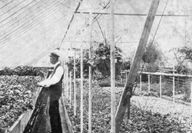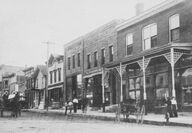Sorted by date Results 147 - 171 of 239

Playing around - Sandy Williams' book, "Images of America - Hinsdale," shows a photo of Burns Field after its 1938 completion. This view is from Monroe Street looking east. The park was named for Village President Randall Burns who died in office, stricken at a village board meeting. Do you have a Hinsdale photo that is at least 25 years old? We'd love to share it with our readers. Stop by our office at 7 W. First St. or email it to [email protected]...

Complete retreat - Sandy Williams' book, "Images of America - Hinsdale," describes how KLM became a park in the village. "The KLM Lodge, a dining and recreation hall for the women's retreat (for employees of International Harvester), was built in 1926. It was designed by Hinsdale architect R. Harold Zook based on an earlier plan for the Legge home intended for the site. A dormitory followed, along with tennis courts, swimming pool and a convalescent cottage. In December 1973,...

Vacation destination - According to Sandy Williams' book, "Images of America - Hinsdale," KLM was once a vacation spot. "Alexander Legge, president of International Harvester, and his wife, Katherine, purchased 52 acres on South County Line Road in 1915 for use as a summer residence and farm. After Katherine died suddenly in 1924, Legge dedicated this property in her name for use as a retreat by the female employees of Harvester. Do you have a Hinsdale photo that is at least...

Special delivery - According to Sandy Williams' book, "Images of America - Hinsdale," Charles Kimball was a Civil War veteran who was troubled by pain from chronic war wounds. He was a patient of Dr. David Paulson, a Chicago physician associated with Michigan's Battle Creek Sanitarium. "Kimball persuaded Paulson to open a branch of the sanitarium in Hinsdale on the former Beckwith estate, shown here. Located north of the railroad tracks near Oak Street, the 10-acre property...

Early worship - Sandy Williams writes in "Images of America - Hinsdale" about the first Zion Lutheran Church, which stood on the northeast corner of Vine and Second streets and was built in 1888. "Two years later, Zion's school was established with classes held in the sanctuary and the pastor serving as the instructor. In 1915, a new church, still standing, was constructed, and this building was used as the school until 1931."...

Early worship - From Sandy Williams' book, "Images of America - Hinsdale," comes this picture of the Swedish Evangelical Church. "Organized about 1889, the Swedish Evangelical congregation built this church at 18 E. Fourth St. At the time, summer school was also held here to teach biblical history and the Swedish language. The first service in English was offered in 1922; in 1935, Swedish services were discontinued altogether. A new church was built in 1931 at Fourth Street...

Early worship - German Lutherans split from their Fullersburg congregation, wanting a church closer to their Hinsdale neighborhood. "In 1900, skilled congregants volunteered their labor and expertise to build this church at the corner of Third and Grant streets," Sandy Williams writes in "Images of America - Hinsdale." "The congregation vacated the building in 1964. Saved from demolition, renovated and reopened to the public, the building, renamed Immanuel Hall, is owned and...

A little bit of France - This home at 314 N. Lincoln St. was built for William D. Gates, founder and president of American Terra Cotta Company. Not surprisingly, the entire exterior was constructed of terra cotta. According to Sandy Williams book, "Images of America - Hinsdale," the design was inspired by a Loire Valley chateau and built by the Chicago architectural firm of Jennery & Mundie. To support the weight of the structure, the basement was divided into rooms matching...

Early dining - From Sandy Williams book, "Images of America - Hinsdale," is this photo of the Old Spinning Wheel restaurant located on Ogden just west of the tollway. "The original Old Spinning Wheel restaurant was built in 1935 by Charles and Vacia Duncan. Expanding seven years later, this building replaced the original structure. The enormously popular restaurant was filled with antiques, surrounded by attractive gardens, and offered an elegant yet home-style menu. The...

Cheers! - It wasn't that long ago where the only place you could be served a drink with your meal was at the Cypress on Ogden Avenue and County Line Road. According to Sandy Williams' book "Images of America - Hinsdale," the Cypress Inn was established in the 1940s on Ogden, just outside of the village limits, where liquor sales were permitted. "The business began as a beer distributorship and grew to include a bar and restaurant. Shown here about 1950, the restaurant...

Summer theater - According to Sandy Williams' book, "Images of America - Hinsdale," "Hollywood came to Hinsdale from 1951 to 1962 when the Hinsdale Theatre presented summer stock performances. The plays were produced by Sidney Blackmer, a well-known actor who called upon stars such as Charlton Heston, Debbie Reynolds and Vincent Price to headline the shows. The stars enjoyed Hinsdale hospitality, staying in the homes of residents during the short runs, at times bringing their...

Farm livin' was the life for them - Walker's Farm was located near Ayres Street and Garfield Avenue and stretched to the county line. Sandy William's book, "Images of America - Hinsdale," describes the area at the time. "There were no houses to the south for eight miles, only prairie and a lone grove of trees. The street, 'The Lane,' was actually the lane that the cows used to reach the barn. Years later, the barn's foundation was broken down and used in paving Ravine...

The Hinsdale Township High School boys golf team won its first state championship 75 years ago Tuesday, May 18. Team members included Ben "Connie" Creed (from left), team captain Henry Heinly, Sam Stout, all of Hinsdale, and Walter Poswilko of Westmont. The team won every dual meet, along with the district and conference meets on the way to state title, according to Poswilko's son, Thomas. Coach Russell Poppenhager led teams to two more state titles in 1954 and 1961. It would...

The little engine that did - Engine No. 9 hauled trains from Chicago to Aurora through Hinsdale from 1865 until 1885. According to "Village on the County Line" by Hugh Dugan, it was an experimental engine built in the 1850s that originally burned wood but was converted to burn coal. Do you have a Hinsdale photo that is at least 25 years old? We'd love to share it with our readers. Stop by our office at 7 W. First St. or email it to [email protected]...

Founding matters - William Robbins, generally regarded as the father of Hinsdale, purchased land from Chicago Avenue to 55th and Madison Street to County Line Road in 1862 for $9,000. "To be near his new venture, Robbins temporarily moved his family to Fullersburg," Sandy Williams writes in "Images of America - Hinsdale." "From here, he had direct supervision of Hinsdale's formation, from the street layout and grading to the tree planting and construction of his own estate....

Calling all cars - From Sandy Williams' book, "Images of America - Hinsdale," this photograph is of Hinsdale's first police chief, John Nicholson. "John Nicholson was named chief of police in 1902, a job he held for 24 years. A two-man force walked patrols, using bicycles or Nicholson's own horse when necessary. Automobiles began arriving in Hinsdale about 1903, and occasionally one would be appropriated to pursue a felon. It was not until about 1921 that Hinsdale purchased a...

Old school - Sandy Williams' book, "Images of America Hinsdale," includes a photo of the high school gymnasium, which was built in 1921 on Washington Street north of the high school. "Spectator seating for 500 was accommodated on a second-floor gallery that surrounded the court below. Beneath the stands, on the first floor, were the locker rooms and storage. The building was razed in 1976 along with the adjacent school to make room for the current Hinsdale Middle School."...

Early transportation - It's hard to imagine traveling by horseback and carriage through town, as Hinsdaleans did when the village was first founded. According to Sandy Williams' book, "Images of America - Hinsdale" "The livery stable was situated just north of the tracks, west of Washington Street. Liveries met all trains and 10 ride tickets could be purchased for $1. Some villages boarded their horses at the stable, others rented buggies for special occasions. This...

Pre-Home Depot - In Sandy Williams' book, "Images of America - Hinsdale," she mentions the building which is still standing at 42 S. Washington St., which was built in 1894. "One of the area's first merchants, John Bohlander opened a grocery and tavern in Fullersburg before moving to Hinsdale in 1871. Here, he operated a general store at 42 S. Washington before his business turned to hardware in 1877. Shown is Bohlander's second building at this address, constructed in 1894...

Lifestyle housing circa 1888 - In her book, "Images in America - Hinsdale," Sandy Williams mentions that the first building on the south side of First Street was this one located at 102 S. Washington St. "In 1888, German born John Papenhause had this building constructed to house his successful tailoring business. The second floor was home to the Papenhausens and their six children."...

Early Hinsdale - Sandy Williams cites this historic edifice in the village's downtown in her book, "Images of America - Hinsdale." She writes, "This building at 54 S. Washington Street was built in 1892 replacing an earlier blacksmith shop. Reineke's Grocery occupied the site from 1904 until closing in 1974 as one of Hinsdale's oldest and most popular businesses."...

Prime location - From Sandy Williams' book, "Images of America - Hinsdale," we learn the building that currently houses Baldinelli's and Vistro Prime has had food as the main course since the beginning. "Built in 1929 at 114 S. Washington Street to house the Loblaw Groceteria, this later became one of the first Jewel food stores in the chain. Loblaw stores featured a new concept of 'self-serve' rather than clerks gathering orders to be delivered later that day. With customers...

Hinsdale's first florist - Morris Florist filled the need for a florist in downtown Hinsdale, according to Sandy Williams' book, "Images of America - Hinsdale" when it opened up on Hinsdale Avenue in 1902. His business eventually expanded to include six greenhouses on the corner of Monroe Street and Ogden Avenue and several others outside of Hinsdale as well. Do you have a Hinsdale photo that is at least 25 years old? We'd love to share it with our readers. Stop by our office...

Green thumb – Sandy Williams, in her book, "Images of America - Hinsdale," writes about Englishman Fred Morris. "Morris established Morris Florists in 1894. Shown about 1907 in the greenhouse near his home at Hickory and Grant Streets, Morris produced shrubs, vegetables and herbs as well as flowers. When the government encouraged victory gardens during the war, Morris volunteered to teach residents proper planting methods." Do you have a Hinsdale photo that is at least 25 y...

Back in the day - From Sandy Williams' book, "Images of America - Hinsdale," this photo shows the west side of Washington Street taken about 1895. "From right to left, the 1891 corner building remains, although remodeled; the two adjacent Joliet limestone storefronts both built in 1894, also stand today. Barely visible at the south end of the block is the familiar round oriel bay window of the corner building." Do you have a Hinsdale photo that is at least 25 years old? We'd...